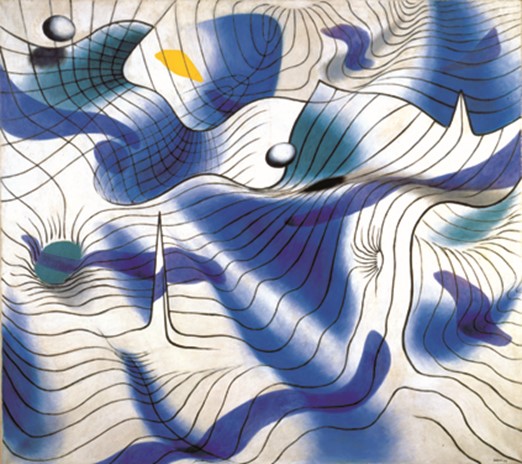
Herbert Bayer
Austrian, 1900-1985 (active Germany, USA)
Lamiferous Landscape, 1944
Oil on canvas
SBMA, Gift of the Estate of Joella Bayer
2006.46.1

Herbert Bayer- Courtesy of Addison Rowe Gallery
“My work seen in its totality is a statement about the integration of the contemporary artist into an industrial society.” - Herbert Bayer
RESEARCH PAPER
A roiling wave on a cartoon sea? A twisting Go Game board? A vast, rolling neon plain in a psychedelic dream? Like much of Bayer’s art, “Lamiferous Landscape” is hard to characterize, yet infinitely alluring.
The piece itself consists of a grid of black, curling lines pushing from the top edge of the canvas towards the center; patches of blue, along with blue worm-like protrusions, seem to strain the brain to reference a swirling ocean. But Bayer isn’t interested in “story,” as such. Probably the last thing he wants us to do. The contrast between blue and black not only creates visual interest but also evokes emotional responses: Blue might symbolize calmness and depth, while black often represents strength and formality. Bayer seems to challenge us with concepts of fluidity and rigidity, of bringing the dynamics of nature - the motions of waves - into a visual construct, of science and art sharing the same space.
A natural outgrowth of his training at the Bauhaus in Weimer, Germany, Bayer studied with Wassily Kandinsky, Paul Klee, and Laszlo Moholy-Nagy. The idea of the Bauhaus, founded by Walter Gropius, was to replace the traditional student-teacher dynamic with a community of artists and reconnect art with everyday life, giving equal importance to architecture, performance, design, and applied arts alongside fine art. Aiming to rethink the very form of modern life, the Bauhaus, with its principles of combining art with industrial design, became the site of a dazzling array of experiments in the visual arts that have profoundly shaped our visual world today.
Herbert Bayer, an Austrian and American graphic designer, painter, photographer, sculptor, art director, environmental and interior designer, and architect was born on April 5, 1900, in Haag, Austria. As a young man, his studies as an architect led him to his Bauhaus years where his crisp, clean, minimalist style impressed his teachers. After his graduation he was appointed director of printing and advertising at the school where he created the Universal alphabet, a typeface consisting of only lowercase letters that would become the signature font of the Bauhaus.
In 1928, he went on to become an art director for Vogue magazine in Berlin and designed tourist pamphlets for the Third Reich’s hosting of the 1936 Olympic Games. Shortly thereafter, he was labeled a “degenerate artist,” and in 1938, he fled Germany when Alfred Barr Jr., founding director of The Museum of Modern Art, invited Bayer to New York to apply his theories of display to the installation of the exhibition: Bauhaus: 1919-1928 at MoMA.
In the U.S., Bayer thrived; For over 60 years he created pioneering works in painting, sculpture, environmental works, industrial design, typography, architecture, photography, and applied design. He was truly what can be referred to as “a renaissance man,” one of the few "total artists" of the twentieth century.
He died in Montecito, California in 1985.
Prepared for the Santa Barbara Museum of Art Docent Council by Laezer Schlomkowitz, 2025
BIBLIOGRAPHY
Bauhaus. Herbert Bayer. (Jan. 29, 2025) aventarte.com
Bauhaus: A Human Adventure. (Jan. 30, 2025) artsandculture.google.com
Bauhaus 1919-1933. Workshops for Modernity (Feb. 1, 2025) moma.org
Resnik Center for Herbert Bayer Studies. (Feb. 1, 2025) thebayercenter.org
